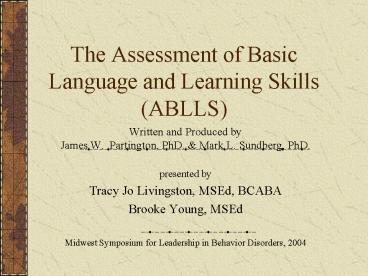The Assessment of Basic Language and Learning Skills ABLLS - PowerPoint PPT Presentation
1 / 15
Title:
The Assessment of Basic Language and Learning Skills ABLLS
Description:
Brooke Young, MSEd. Midwest Symposium for Leadership in Behavior Disorders, 2004. The Goal ... Want to leave time for incidental learning and generalized instruction ... – PowerPoint PPT presentation
Number of Views:1722
Avg rating:3.0/5.0
Title: The Assessment of Basic Language and Learning Skills ABLLS
1
The Assessment of Basic Language and Learning
Skills (ABLLS)
- Written and Produced by James W. Partington,
PhD. Mark L. Sundberg, PhD. - presented by
- Tracy Jo Livingston, MSEd, BCABA
- Brooke Young, MSEd
- Midwest Symposium for Leadership in Behavior
Disorders, 2004
2
The Goal
- Teaching should result in the acquisition of
generalized skills that allow the learner to
learn from his everyday experiences. - Dr. James Partington
- 10/09/03
3
Verbal Behavior
- Based on B.F. Skinners book Verbal Behavior
(1957) which proposes that - language is a behavior
- language is influenced primarily through
reinforcement - and that establishing and maintaining the
motivation to learn is critical for the
acquisition of verbal behavior - The Mariposa School, 2003
4
The ABLLS
- Assessment Curriculum Guide
- Scoring Instructions and IEP Development Guide
- Teaching Language to Children with Autism or
Other Developmental Disabilities
5
ABLLS Protocol
- Basic Learner Skills (Sections A-P)
- Academic Skills (Sections Q-T)
- Self-Help Skills (Sections U-X)
- Motor Skills (Sections Y-Z)
6
Why Should I Use the ABLLS?
- To help identify language and other critical
skills in need of intervention necessary for a
child to become more capable of learning from his
everyday experiences - To provide a method for identifying a childs
specific skills in a variety of learning domains - To provide a curriculum guide
- To provide a method for visually displaying the
acquisition of new skills
7
Limitations of the ABLLS
- Not designed to provide age norms
- Not designed to compare student to his/her peers
- Not all of the domains are based on scope and
sequence progression
8
Who Can Complete the ABLLS?
- Parent
- Educator
- Behavior analyst
- Psychologist
- Speech language pathologist
- Occupational therapist
- Other professionals responsible for developing
monitoring the students educational program
9
Domains on the ABLLS
- Cooperation Reinforcer Effectiveness
- Visual Performance
- Receptive Language
- Imitation
- Vocal Imitation
- Requests (mands)
- Labeling (tacts)
- Intraverbals
- Spontaneous Vocalizations
10
Domains (continued)
- Syntax Grammar
- Play Leisure
- Social Interaction
- Group Instruction
- Classroom Routines
- P. Generalized Responding
- Q. Reading
- R. Math
11
Domains (continued)
- Writing
- Spelling
- Dressing
- Eating
- Grooming
- Toileting
- Gross Motor
- Fine Motor
12
Behavioral Language Assessment (Brief Assessment)
- Designed to reflect the average performance of a
typical 2-3 year old child - Assists with determining weaknesses in a childs
verbal repertoire and where to begin with a
language intervention program - Quick easy tool which can be used to jump
start programming
13
Scoring Tracking
- Under score vs. over score be conservative
- No basal or ceiling
- Dont assume if you dont know exact level,
observe or assess particular skill - Do it before any major change in programming
(typically 1.5 months prior to IEP) - Update when student is making quick progress
(early learner)
14
Scoring Tracking (continued)
- Each row of columns includes
- Task (i.e. A3,H7, L2)
- Scores ( 0-2, 0-4)
- Task name (i.e. Look at non-reinforcing item)
- Task objective (i.e. student will look at a
non-reinforcing item presented by an instructor) - Question (i.e. If you hold up a non-reinforcing
item, will the student look at it?) - Examples (i.e. when you hold up a shoe, student
will look at it) - Criteria (i.e. 2 readily finds in any position,
1 requires some prompts to respond)
15
IEP Development
- Usually 20-30 objectives
- Want to leave time for incidental learning and
generalized instruction - Add new tasks/objectives when others are
mastered - Most objectives will be devoted to basic learner
skills (A-P)































